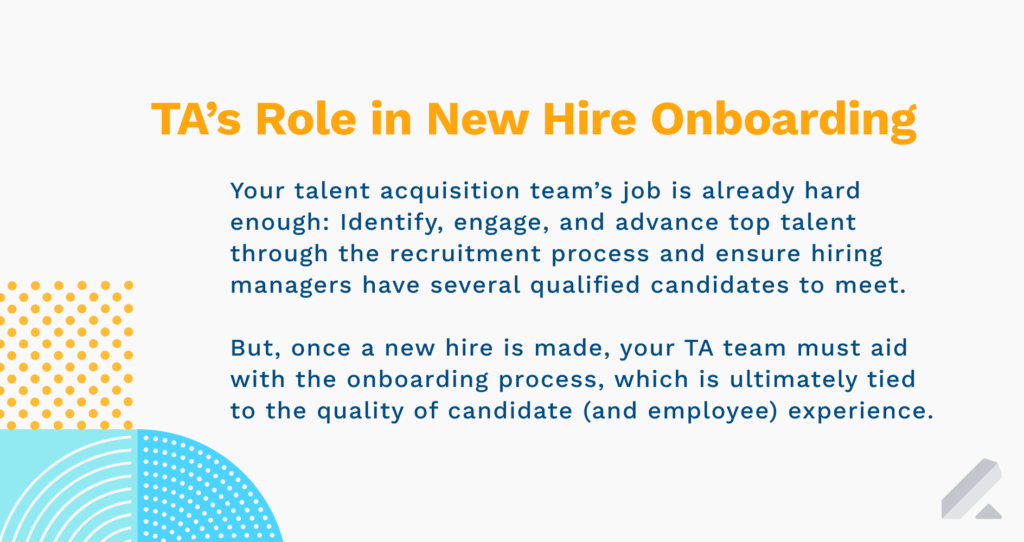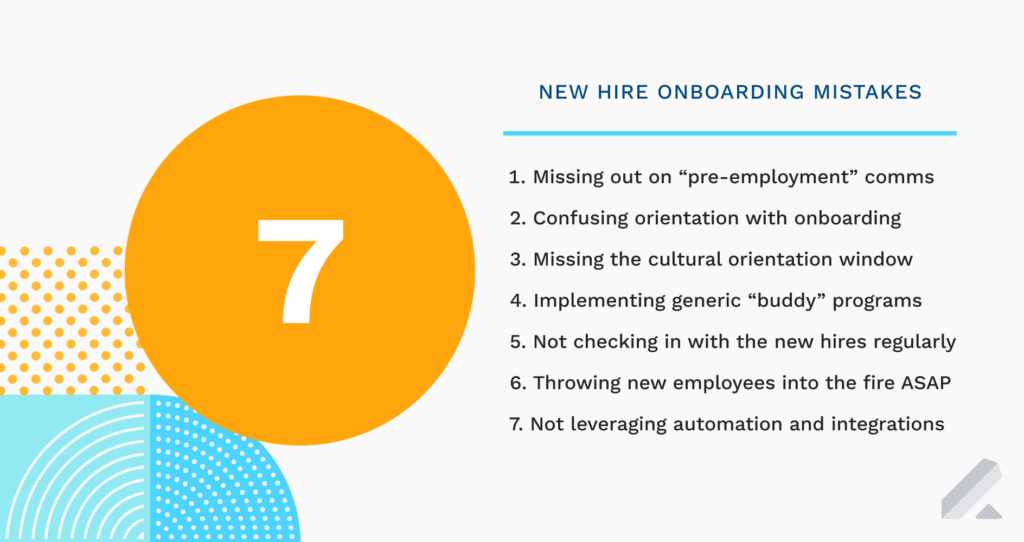Employee attrition is on the rise and putting pressure on already-burdened talent acquisition and HR professionals who are working in tandem to hire and retain top talent.
Losing employees via resignation impacts your business in many ways. One of the biggest impacts your executive staff will undoubtedly notice is the financial side of it:
- In 2022, Gartner predicted that U.S. employee annual voluntary turnover would likely jump nearly 20% from a yearly pre-pandemic average.
- Moreover, SHRM estimates that it costs the average company six to nine months of an employee’s salary to identify and onboard a replacement.
A major contributor to greater attrition is a poor new hire onboarding experience — one that makes new employees feel alienated and/or prevents them from hitting the ground running in their roles following new-hire orientation.
The good news? Your talent team can liaise with your human resources colleagues and hiring managers to make the necessary, data-backed changes to realize a smoother and more effective onboarding process.
Specifically, you can work together to create an onboarding checklist and optimize your new employee handbook and training sessions to helps new staff members seamlessly transition from the end of the recruiting process to their first days, weeks, and months on the job.

7 common new hire onboarding issues to know
There are seven mistakes that can be detrimental to your new hire onboarding process.
1) Missing out on pre-employment communication
Welcome emails are often the first official communication after a candidate accepts the offer. A well-crafted welcome email sets a positive tone for the employee experience.
Your TA team can help HR and hiring managers improve this step in two ways.
First, you can use your relationship with a new hire to encourage them to submit all necessary paperwork before their first day (and reduce stress as they get started).
Second, you can suggest a personalized touch (e.g., a short welcome video or message from the hiring manager) to make a hire feel welcome and valued from the get-go.
2) Confusing orientation with onboarding
Some companies use onboarding and orientation interchangeably, but shouldn’t:
- Onboarding is an ongoing effort that could take up to 12 months. The process includes various activities that gradually introduce employees to their new company culture, goals, and stakeholders across the business.
- Orientation, meanwhile, is a time-based activity that is more administrative, including HR paperwork, payroll setup, IT, and workplace safety training.
Confusing onboarding with orientation creates a missed opportunity to set new hires up for success. A well-organized onboarding program should answer questions like:
- What is the exact onboarding roadmap, and how long will it last?
- What distinct role will HR, direct managers, and team members play?
- How will we showcase our workplace culture to new employees?
- How will we gather feedback on the program to measure success?
3) Missing the cultural orientation window
New hires have a short 90-day window to adapt to your company culture. A successful onboarding process will introduce the new hire to the culture of the org, including:
- Long-term company mission, goals, and values
- Ideal communication methods for the business
- How the company deals with and resolves conflict
- Management styles the company nurtures/rewards
- Challenges and opportunities for the company culture
- Even the standard dress code you have for the office
That’s quite a list to add into an already-packed onboarding agenda.
There are two task your TA team can handle, though, that tie into new hire onboarding and provide recently employed individuals an early intro to the company culture:
- 1) Form a diverse interview panel that represents the org’s commitment to DEI.
- 2) Coach interview panelists to showcase company values when interviewing.
Let’s say one of your values is transparency.
You can take the lead in sharing the challenges the new hire would face should they accept an offer with your company. It gives the candidate a realistic view of the role expectations while showcasing how you “live and breathe” your company values.
In both activities, be sure to include info on your company culture and values in job postings so the candidates learn about them even before they apply.
More to the point, you can help the candidates understand how those values come to life by including real stories about employees in your introduction conversation.

4) Implementing generic, lackluster “buddy” programs
An orientation buddy program is a proven way to provide employees with a meaningful connection to their new workplace. Think of it as a mentorship program of sorts.
An assigned buddy can help a new hire understand the company culture, answer questions about tools and processes, and provide general support during the first few weeks.
Choosing the right buddy and tailoring the process to the new hires’ needs, though, can make a big difference. Recruiters learn a lot about the candidates during the hiring process.
Your TA team can help hiring managers and HR personalize the buddy program by:
- Recommending (what you deem) the ideal team member to be paired with a new hire (i.e., a knowledgeable employee that matches their personality type and can shed light on day-to-day duties and the business at large)
- Facilitating “pre-boarding” introductions between the buddy and the new hire to make the new hire feel welcome and give them a head start before their first day
- Encouraging hiring managers and buddies to connect as soon as possible, preferably before the new hire’s start date, so the former can share the role description, goals, KPIs, and even potential challenges with the buddy, who can then offer the appropriate guidance to the new hire
5) Not checking in with the new hires regularly
New job anxiety is typical: A new hire could experience a range of concerns, from learning new tools and processes to ensuring they make a good impression on their team members.
That’s why checking in to ask/answer questions during onboarding is vital.
We recommend hiring managers check in with their new hires at the end of their first day, first week, first month, and after three months. The TA team who helped fill the position, though, can and should also perform some of these check-ins.
For instance, your TA team can build on your existing relationship with a new employee (based on your previous recruiting engagement) to get their feedback on role expectations during and after the interview process (i.e., amid the employee onboarding process).
6) Throwing new employees into the fire immediately
It’s tempting to give new employees — especially those with more experience — important tasks, projects, and responsibilities to tackle right away.
However, doing so can inadvertently set the stage for a new hire’s early exit.
Instead of assigning new hires challenging projects right out of the gate, give them confidence with lower-hanging fruit. A good example is creating and achieving a realistic 30-, 60-, and 90 day-plan that includes specific onboarding goals.
This would encourage the new hires to focus on their onboarding and getting a lay of the land, so to speak, about the work environment, which can lead to improved employee morale.
7) Not leveraging automation and integrations
The importance of structured onboarding is clear to people leaders. Still, the tools available to many people ops teams are often spread across spreadsheets, email templates, Slack reminders, and calendar events.
This disjointed system can result in highly manual and inefficient processes when onboarding new employees and, therefore, undermine the new hire experience.
Lever’s integrations with onboarding tools like Sapling enables companies with our ATS + CRM solution to run a streamlined onboarding program with greater visibility and consistency.
With the Lever and Sapling integration, you can:
- Push hired candidate info automatically from Lever into Sapling to populate a new employee profile (no more spreadsheets or manual data entry)
- Assign paperwork, welcome the new hire, and initiate team and role onboarding through a company-branded pre-boarding experience
- Automate onboarding workflows, triggered notifications, and reminders across multiple departments, locations, and stakeholders
- Empower managers to ramp up new hires with objective-based onboarding roadmaps that support new hire success from day one on the job
Learn how your talent acquisition team can revamp your recruiting efforts to better attract, engage, and convert high-quality candidates. Schedule a call with a Lever rep today.



